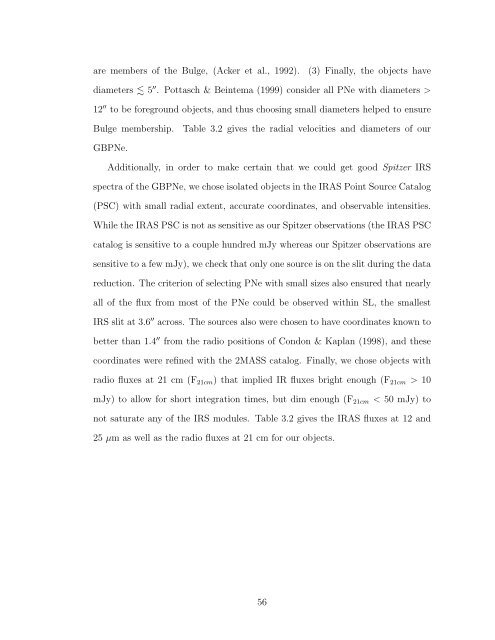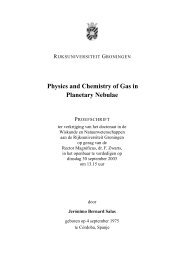TRACING ABUNDANCES IN GALAXIES WITH THE SPITZER ...
TRACING ABUNDANCES IN GALAXIES WITH THE SPITZER ...
TRACING ABUNDANCES IN GALAXIES WITH THE SPITZER ...
You also want an ePaper? Increase the reach of your titles
YUMPU automatically turns print PDFs into web optimized ePapers that Google loves.
are members of the Bulge, (Acker et al., 1992). (3) Finally, the objects have<br />
diameters � 5 ′′ . Pottasch & Beintema (1999) consider all PNe with diameters ><br />
12 ′′ to be foreground objects, and thus choosing small diameters helped to ensure<br />
Bulge membership. Table 3.2 gives the radial velocities and diameters of our<br />
GBPNe.<br />
Additionally, in order to make certain that we could get good Spitzer IRS<br />
spectra of the GBPNe, we chose isolated objects in the IRAS Point Source Catalog<br />
(PSC) with small radial extent, accurate coordinates, and observable intensities.<br />
While the IRAS PSC is not as sensitive as our Spitzer observations (the IRAS PSC<br />
catalog is sensitive to a couple hundred mJy whereas our Spitzer observations are<br />
sensitive to a few mJy), we check that only one source is on the slit during the data<br />
reduction. The criterion of selecting PNe with small sizes also ensured that nearly<br />
all of the flux from most of the PNe could be observed within SL, the smallest<br />
IRS slit at 3.6 ′′ across. The sources also were chosen to have coordinates known to<br />
better than 1.4 ′′ from the radio positions of Condon & Kaplan (1998), and these<br />
coordinates were refined with the 2MASS catalog. Finally, we chose objects with<br />
radio fluxes at 21 cm (F21cm) that implied IR fluxes bright enough (F21cm > 10<br />
mJy) to allow for short integration times, but dim enough (F21cm < 50 mJy) to<br />
not saturate any of the IRS modules. Table 3.2 gives the IRAS fluxes at 12 and<br />
25 µm as well as the radio fluxes at 21 cm for our objects.<br />
56













